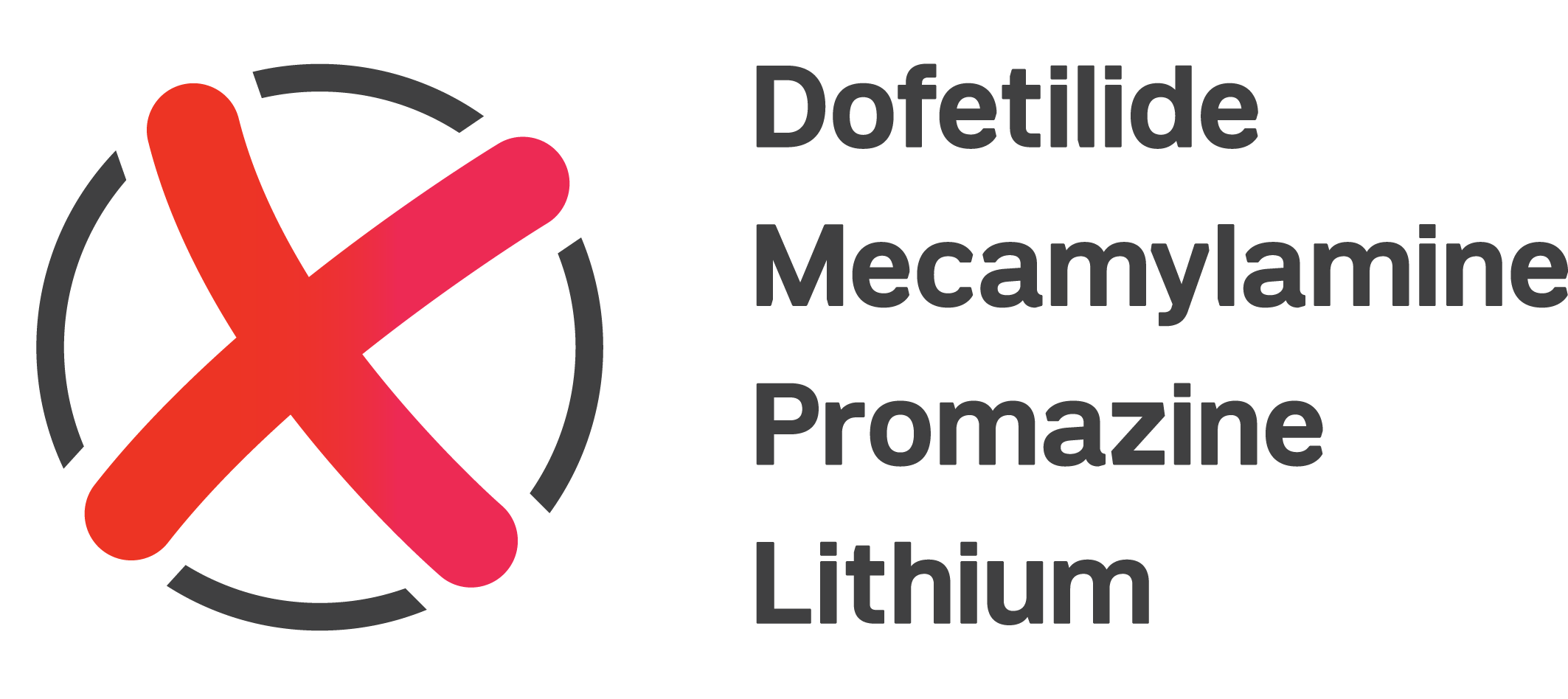The prescribing information for dofetilide cites a drug interaction with hydrochlorothiazide (HCTZ).1 Co-administration of dofetilide (500 mcg twice daily) with HCTZ (50 mg once daily) for five days, followed by two days of HCTZ at half dose, resulted in an increased dofetilide plasma concentration by 27% and an increased maximum serum concentration of dofetilide of 21%.1 QTc prolongation caused by dofetilide increased 197% overtime, with a 95% increase in maximum interval prolongation with HCTZ co-administration.1 Although the listed contraindication specifically notes hydrochlorothiazide, thiazides are often considered equivalent to thiazide-like diuretics,2 therefore the likelihood of chlorthalidone producing a similar interaction should be considered. Furthermore, dofetilide prescribing information cautions the use of potassium-depleting diuretics as hypokalemia or hypomagnesemia may occur, increasing the potential for Torsade de Pointes.1 Studies have found that chlorthalidone causes a greater reduction in potassium than HCTZ.3-5
The promazine hydrochloride drug label also notes increased risk of hypokalemia when promazine hydrochloride is taken with diuretics which can increase the risk of ventricular arrhythmias, including Torsade de Pointes.6
Levosulpride (which is not used in the United States) and mecamylamine are also categorized as drugs to avoid combining with chlorthalidone.7 Thiazide and thiazide-like diuretics may enhance adverse/toxic effects of levosulpride and mecamylamine. 7 Urinary excretion of mecamylamine is pH dependent, where alkalinization of urine reduces and acidification increases excretion.8 The pH sensitive elimination of mecamylamine along with the possibility of electrolyte disturbances caused by diuretics7 may be involved in the mecamylamine and thiazide-like diuretics interaction.
There are numerous potential interactions between diuretics and other pharmaceuticals.
Bile acid sequestrants such as cholestyramine and colestipol may decrease the efficacy of thiazide and thiazide-like diuretics.9-11 Studies have shown that combination therapy of bile acid sequestrants with thiazide and thiazide-like diuretics reduce serum concentration of the diuretic. In one study, co-administration with cholestyramine reduced plasma concentration of HCTZ by >50%.9 A follow-up study found that dosing cholestyramine four hours after HCTZ to be the most ideal dosing schedule, although plasma concentration of HCTZ still decreased by at least 30% to 35%.10
Diuretics may increase the risk of acute phosphate nephropathy in patients taking sodium phosphates such as OsmoPrep and Visicol. 12-14
Amifostine, a cytoprotective agent used during chemotherapy and radiation15, and obinutuzumab, a chemotherapy drug16, may cause hypotension when used with diuretics.15,16
In a pharmacokinetic study, drug interactions between topiramate and three antihypertensive agents (diltiazem, HCTZ, and propranolol) were evaluated. Renal clearance of topiramate decreased 22-30% (P<0.05) and systemic exposure increased 27-29% when taken with 25 mg of hydrochlorothiazide.17 The prescribing information for topiramate lists an interaction with thiazides and thiazide-like diuretics, citing an increased risked of hypokalemia when the two drugs are taken concurrently.18 Incidence of hypokalemia with combination therapy of HCTZ and topiramate was 61% compared to monotherapy, which was 27% with topiramate and 25% with HCTZ.18
A few studies provide evidence of an interaction between diuretics and lithium.19-22 Concurrent use of lithium and thiazide diuretics can lead to an increased concentration of lithium.23 Thiazide diuretics increase reabsorption of sodium in the proximal tubule. This subsequently causes reabsorption of lithium which leads to decreased elimination of lithium and the potential for lithium toxicity.23
References
- Weber MA, Schiffrin EL, White WB, et al. Clinical practice guidelines for the management of hypertension in the community. The journal of clinical hypertension. 2014;16(1):14-26.
- Chobanian AV, Bakris GL, Black HR, et al. The seventh report of the joint national committee on prevention, detection, evaluation, and treatment of high blood pressure: the JNC 7 report. Jama. 2003;289(19):2560-2571.
- Peterzan MA, Hardy R, Chaturvedi N, Hughes AD. Meta-analysis of dose-response relationships for hydrochlorothiazide, chlorthalidone, and bendroflumethiazide on blood pressure, serum potassium, and urate. Hypertension. 2012;59(6):1104-1109.
- Ernst ME, Carter BL, Zheng S, Grimm RH. Meta-analysis of dose–response characteristics of hydrochlorothiazide and chlorthalidone: effects on systolic blood pressure and potassium. American journal of hypertension. 2010;23(4):440-446.
- Dorsch MP, Gillespie BW, Erickson SR, Bleske BE, Weder AB. Chlorthalidone Reduces Cardiovascular Events Compared With Hydrochlorothiazide. Hypertension. 2011;57(4):689-694.
- Promazine Hydrochloride. 2016. Accessed 02/16/2017.
- Chlorthalidone. Walters Kluwer Health. http://online.lexi.com. Accessed 7/1/16.
- (mecamylamine) V. Prescribing Information.
- Hunninghake D, King S, LaCroix K. The effect of cholestyramine and colestipol on the absorption of hydrochlorothiazide. International journal of clinical pharmacology, therapy, and toxicology. 1982;20(4):151.
- Hunninghake DB, Hibbard DM. Influence of time intervals for cholestyramine dosing on the absorption of hydrochlorothiazide. Clinical Pharmacology & Therapeutics. 1986;39(3):329-334.
- Kauffman RE, Azarnoff DL. Effect of colestipol on gastrointestinal absorption of chlorothiazide in man. Clinical pharmacology and therapeutics. Sep-Oct 1973;14(5):886-890.
- Brunelli SM, Lewis JD, Gupta M, Latif SM, Weiner MG, Feldman HI. Risk of kidney injury following oral phosphosoda bowel preparations. Journal of the American Society of Nephrology. 2007;18(12):3199-3205.
- Hurst FP, Bohen EM, Osgard EM, et al. Association of oral sodium phosphate purgative use with acute kidney injury. Journal of the American Society of Nephrology. 2007;18(12):3192-3198.
- Russmann S, Lamerato L, Marfatia A, et al. Risk of impaired renal function after colonoscopy: a cohort study in patients receiving either oral sodium phosphate or polyethylene glycol. The American journal of gastroenterology. 2007;102(12):2655-2663.
- Ethyol (amifostine) for Injectiotn. U.S. Bioscience, Inc.; 1999.
- Gazyva Full Prescribing Information. 2016. Accessed 02/16/2017.
- Manitpisitkul P, Curtin CR, Shalayda K, Wang SS, Ford L, Heald D. Pharmacokinetic interactions between topiramate and diltiazem, hydrochlorothiazide, or propranolol. Clinical pharmacology in drug development. 2014;3(5):378-387.
- Topamax (topiramate). Janssen-Orth Inc.
- Jefferson JW, Kalin NH. Serum lithium levels and long-term diuretic use. JAMA. 1979;241(11):1134-1136.
- Himmelhoch JM, Poust RI, MaIlinger AG, Hanin I, Neil JF. Adjustment of lithium dose during lithiumchlorothiazide therapy. Clinical Pharmacology & Therapeutics. 1977;22(2):225-227.
- Mack JE, Amyx BC. Comparison of the effects of hydrochlorothiazide and furosemide on lithium disposition. The American journal of psychiatry. 1991;148(8):1060.
- Poust R, Mallinger A, Mallinger J, Himmelhoch J, Neil J, Hanin I. Effect of chlorothiazide on the pharmacokinetics of lithium in plasma and erythrocytes. Psychopharmacology communications. 1975;2(3):273-284.
- Finley PR, Warner MD, Peabody CA. Clinical relevance of drug interactions with lithium. Clinical pharmacokinetics. 1995;29(3):172-191.




